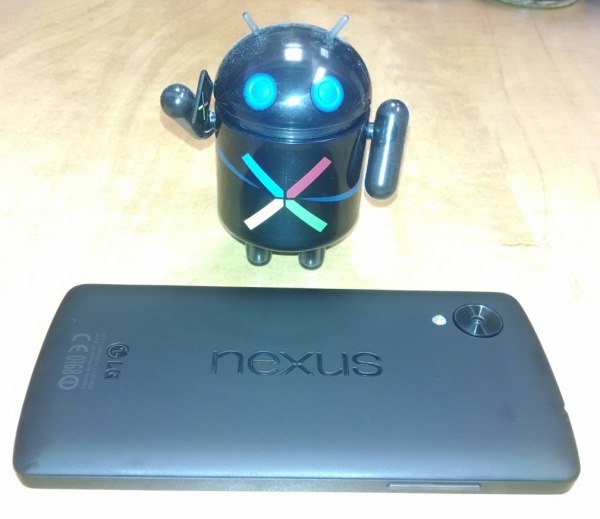Nexus 5 -- meh, it's OK [Review]
While I love Android, I am open-minded. Despite the fact that I collect Android figures, I am no "fan-boy" of Google's mobile operating system. My choice to use the OS is because I like it. Over the years, I have tried Palm OS, iOS, Blackberry, and Windows Phone -- all of these smartphone-focused operating systems are good in their own ways. However, I fell in love with the counter-culture aspect of Android -- hacking, rooting, flashing roms; it was fun.
The holy grail of this sub-culture of Android is the Nexus smartphone. You see, these phones are easy to tinker with because you can easily unlock the bootloader, plus they have a pure Android experience. The newest such smartphone, the Nexus 5, has the Android community giddy with excitement. The phone sold out almost immediately and it is currently on backorder for weeks. If you check eBay, you will find the device selling for more than MSRP. You must be thinking that this phone is amazing right? I am sorry to say it's not. It's just OK. It's also one of the best Android phones you can buy. Confused? Read on.
Hardware
Upon removing the Nexus 5 from the box, I was immediately impressed with the build quality. It feels remarkably light and doesn't creak. Comparatively, my last Nexus device, the Galaxy Nexus by Samsung, was a plasticy creaky mess. It felt cheap and squeezing the chassis produced audible creaking -- yuck!
The Nexus 5 design is very understated; black and minimalistic with Nexus etched in the back. In other words, it is sexy as hell. While the back of the phone is a bit boring compared to the flamboyantly checkered glass-backed Nexus 4, the Nexus 5 goes for function over form -- no glass but more durability. Kudos to LG and Google for this.
On the subject of hardware, let's get the full specs out of the way:
- Screen -- 4.95-inch 1920x1080 display (445 ppi), Full HD IPS, Corning Gorilla Glass 3
- Camera -- 1.3MP front facing, 8MP rear facing with optical image stabilization
- Size -- 69.17 x 137.84 x 8.59 mm
- Weight -- 4.59 oz (130 g)
- Battery -- 2,300 mAh, wireless charging
- Audio Output -- Built-in speaker, 3.5mm stereo audio connector
- CPU -- Qualcomm Snapdragon 800, 2.26GHz
- GPU -- Adreno 330, 450MHz
- Wireless -- Dual-band Wi-Fi (2.4G/5G) 802.11 a/b/g/n/ac
- Other radios -- NFC (Android Beam), Bluetooth 4.0 LE
- Memory -- 16GB or 32GB internal storage
- RAM -- 2GB
This phone can be used on any GSM carrier in the USA and amazingly, Sprint's CDMA network too. This should give the device a much higher resale and overall value, since your pool of interested buyers will be larger. Sadly, but not unexpectedly, Verizon is not supported. While this carrier is very good from a coverage standpoint, its treatment of the Android community has been poor. The Galaxy Nexus for example, the last Verizon Nexus device, was infamous for its lack of timely updates and attention from the popular carrier. Verizon is also blocking the Nexus 7 2013 LTE from its network. Boo!
Google has aggressively priced the Nexus 5 as well. The 16GB variant is $349, while the 32GB variant is $399. My suggestion would be the 32GB model since sadly, there is no microSD slot. Similarly specced smartphones usually cost close to double without subsidization. It is worth questioning if Google is losing money on each handset.
I successfully tested the wireless charging with the Nokia DT-900 charging plate and it worked brilliantly. It even worked with a case on the device. This is one of my favorite features of the Nexus 5 as I hate fumbling with a wire in the middle of the night searching for the correct way to insert it. Mindlessly placing it on a charging pad is a refreshing and rewarding experience.
Much has been said about the rear camera on the Nexus 5 on various Google+ and forum posts -- much of it negative. However, any negative sentiment is grossly exaggerated because the camera is actually good. While the pictures are not as brilliant as the ones produced by my Nokia Lumia 928, they are far better than the ones taken by the Moto X. I would trust the Nexus 5 and its optical image stabilization to capture my precious family memories.
Battery life is a bit disappointing. The 2,300 mAh variant inside the Nexus 5 is not sufficient for all-day use. I often found myself having to charge it during my day. This is in stark contrast to the Droid Maxx or the Nexus' sister device, the LG G2 which can go multiple days without charging (both devices have larger batteries). While the overall slim-build of the Nexus 5 is appreciated, I would have preferred a thicker device with a larger battery -- function over form.

KitKat
Of course, hardware specifications are only a small part of the allure. The other huge selling-point is that this is the first phone running Android 4.4 dubbed "KitKat". While I am less than enthusiastic about the corporate candy logo tie-in, the operating system is very good. However, it does not differ very much from the Jelly-bean variation. The most noticeable change really is not part of the OS at all -- it is the launcher.
Starting with the Nexus 5 and KitKat, Google has introduced a much smoother and buttery launcher. To many users, the launcher is the operating system (even though this is not correct). After all, that is really what they interact with. And so, the most interesting thing about KitKat technically isn't KitKat at all. In fact, this launcher can run on Jelly Bean devices with the proper files.
Other than the launcher, it's really the same-old Android that we have seen. Nothing has been radically changed on the surface. For some, that is a good thing. After all, you don't want to re-learn your operating system with every update. However, why does the the media and tech community attack Apple for not innovating, while Google is essentially doing the same thing? Heck, at least the iPhone 5s has a fingerprint reader, what is new here?
Shockingly (to me at least), the touch-less voice interactions of the Moto X and Droid Maxx are not found on the Nexus 5. While this can be expected due to the different hardware and software designs, it is still disappointing that Google has chosen to fragment the experience between Nexus and Moto X users. It is a sad state of Android-affairs when the brand new Nexus smartphone is lacking a crucial feature already in the wild (especially since Motorola is a Google-owned company).
Conclusion
I can talk price, specs and software versions until I am blue in the face but the ultimate test is the experience. In other words, how does the Nexus 5 make you feel? This is where the "meh" comes in. It feels very boring -- evolutionary rather than revolutionary. From the Galaxy Nexus to the Nexus 4 and now the Nexus 5, the experience is pretty much identical. Sure, the Nexus 5 is faster, has a better camera and wireless charging but there is no excitement or warm fuzzy feelings.
With that said, even though I am less than blown-away by the Nexus 5, it is still the best Android device you can buy -- if you want an unlocked smartphone or the pure Android experience. If you don't care about pure-Android and just want a cheaper or free smartphone with subsidy, look elsewhere. Overall, it is inexpensive, unlocked for multiple carriers and fast as heck. Recommended.
Photo Credit: Brian Fagioli
